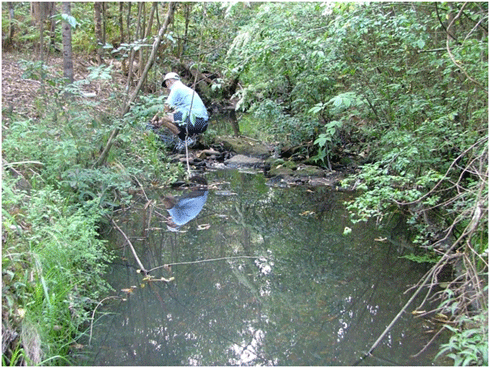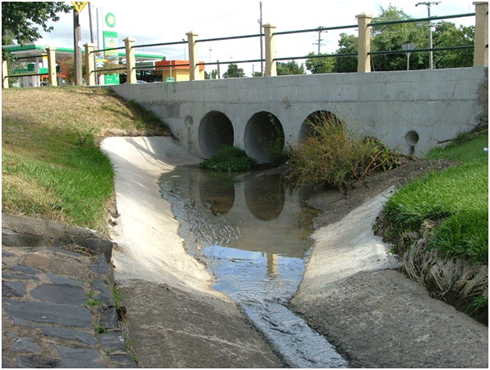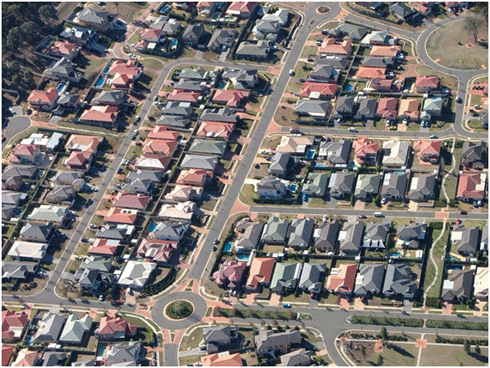
|
Published: 13 February 2012
Concrete pushing urban water quality ‘over the edge’?
It’s known as urban stream syndrome. The streams and rivers running through many of our cities are getting sick: not just from the pollution and waste carried by stormwater into gutters and drains, but from another, unexpected source – the concrete pipes and infrastructure carrying the water.
Concrete pipes, drains, gutters and other urban surfaces that come into contact with runoff are the backbone of our extensive urban drainage system. But, these impervious surfaces release elevated and unnatural levels of minerals that are slowly dissolving and changing the quality of stormwater.
We already know that high sediment loads, nitrogen and phosphorus plant nutrients, and a long list of chemical pollutants – such as heavy metals and pesticides – contaminate urban waterways. The level of degradation is almost directly proportional to the area of catchment modified by urban human activity.
Our research has shown that the process of concrete dissolution and water contamination can be rapid.1 When we recirculated rainwater from a northern Sydney location through a concrete pipe for just 1 hour 40 minutes, the pH of the recirculated water jumped more than three pH units: from an acidic 4.7 to a strongly alkaline 7.9.2 The salinity of the water also doubled.
Two minerals in particular contributed to these changes – calcium and bicarbonate. While barely detectable in the original rainwater, levels of these minerals were elevated after recirculation through the concrete pipe. Calcium and carbonate ions are abundant in limestone, which is an ingredient of concrete.

|
|
A researcher collects water samples from the degraded Quarry Creek in the highly urbanised Lane Cove catchment, northern Sydney. Credit:
Sophia Findlay
|
Other studies have established that the degree of impervious surfaces in urban areas is closely related to the degree of degradation of freshwater stream ecosystems.3
For example, a field survey of water quality of creeks in northern Sydney showed a relationship between pH, salinity, calcium and bicarbonate levels and the level of catchment imperviousness. One group of six creeks flowed through urban catchments, with around 25 per cent of the ground covered by hard, impervious surfaces. A second group of similar-sized creeks flowed through catchments dominated by bushland that had around two per cent impervious surfaces.
The difference in water quality between the two groups of creeks echoed the findings of our recirculation experiment. The pH level was more than one unit higher in the urban streams compared with the bushland streams, while the salinity level of the urban streams was more than twice as high and calcium levels were nearly seven times higher. Bicarbonate levels were more than 10 times higher in the urban streams than the bushland streams.
What are the environmental implications of changes to pH, salinity, calcium and bicarbonate in urban waters? These chemical changes probably exert a strong influence on the base of the aquatic food chain: particularly on the microscopic water plants known as algae.4
Previous studies in northern Sydney have shown that urban streams in the area have highly degraded ecosystems, with sensitive invertebrate groups missing and exotic pest species flourishing.5
The causes of this are complex. Aquatic plants and animals in urban streams are already faced with elevated levels of excessive nutrients and contaminants, along with depleted dissolved oxygen. The shift in pH and relative increase in calcium and bicarbonate from concrete may push this ‘stress level’ further.
Urban stream syndrome is a particularly important threat to streams of high conservation value, such as those in national parks. Many streams in national parks around the Sydney Basin are exposed to urban water pollution, as much of the land at higher elevations has been cleared and covered by urban settlements. For example, the Blue Mountains National Park (and World Heritage Area) has a 30-kilometre string of townships along a series of ridges along the highest altitudes within the park.

|
|
An urban waterway, fully lined with concrete. Credit:
Ian Wright
|
It is worth considering the source of salts and minerals in rivers, stream and lakes across the world. A seminal paper published in Science in 1970 produced a model that explained the ionic chemistry of the world’s surface waters.6 Basically, there are two sources of salts: the ocean and the geological material within water catchments. Generally, ocean salts reach fresh water in the form of atmospheric fallout – as we see in corroding metal in structures near the beach. Our research suggests that concrete urban drainage infrastructure is an additional – previously overlooked – artificial, ‘geological’ source of salts and minerals.
While concrete contamination alone may not be a critical threat in urban streams that flow in catchments with a natural limestone geology, our findings suggest that in some situations, concrete contamination may be contributing to urban stream syndrome.
For example, recent data from the Georges River catchment, south-west of Sydney, reveals that urban streams are ecologically very sick.7 The bicarbonate (alkalinity) levels in the most highly urbanised catchment streams are more than 40 times higher than the ‘natural’ levels typically recorded in Georges River bushland catchment streams. In this situation at least, it is likely that urban concrete stormwater infrastructure is having a constant degrading effect on urban streams.
Dr Ian Wright lectures at the University of Western Sydney (UWS), where he has worked as a postdoctoral research fellow in the field of freshwater ecology. He has a particular interest in pollution ecology and the use of freshwater fauna as pollution indicators. Prior to UWS, he worked at Sydney Water in a similar field. |
1 Wright, I.A., Davies, P.J., Findlay, S.J., and Jonasson, O.J. (2011) A new type of water pollution: concrete drainage infrastructure and geochemical contamination of urban waters. Marine and Freshwater Research 62, 1355–1361. http://dx.doi.org/10.1071/MF10296.
2 Davies, P.J., Wright. I.A., Jonasson, O.J., and Findlay, S.J. (2010) Impact of concrete and PVC pipes on urban water chemistry. Urban Water Journal 7(4), 233–241.
3 Walsh, C.J., Sharpe, A.K., Breen, P.F., and Sonneman, J.A. (2001). Effects of urbanisation on streams of the Melbourne region, Victoria, Australia. I. Benthic macroinvertebrate communities. Freshwater Biology 46, 535–551.
4 Potapova, M., and Charles, D.F. (2003). Distribution of benthic diatoms in US rivers in relation to conductivity and ionic composition. Freshwater Biology 48, 1311–1328.
5 Davies, P.J., Wright, I.A., Jonasson, O.J., Findlay, S.J., and Burgin, S. (2010) Impact of urban development on aquatic macroinvertebrates in south eastern Australia: degradation of in-stream habitats and comparison with non-urban streams. Aquatic Ecology 44, 685–700.
6 Gibbs, R.J. (1970) Mechanisms controlling world water chemistry. Science 170(3962), 1088–1090. http://dx.doi.org/10.1126/science.170.3962.1088.
7 Tippler, C., Wright, I.A., and Hanlon, A. (2012) Development of regional freshwater water quality and catchment guidelines for the conservation of aquatic ecosystems: a case study from the Georges River catchment. In Grove, J.R., and Rutherfurd, I.D. (eds). Proceedings of the 6th Australian Stream Management Conference, Managing for Extremes. 6–8 Februrary, 2012, Canberra. Published by the River Basin Management Society, pp. 519–525.




